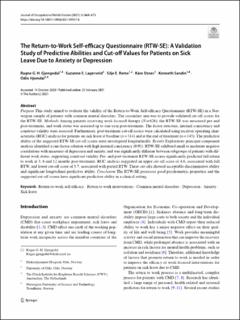| dc.contributor.author | Gjengedal, Ragne Gunnarsdatter Hole | |
| dc.contributor.author | Lagerfeld, Suzanne E. | |
| dc.contributor.author | Reme, Silje Endresen | |
| dc.contributor.author | Osnes, Kåre | |
| dc.contributor.author | Sandin, Kenneth | |
| dc.contributor.author | Hjemdal, Odin | |
| dc.date.accessioned | 2023-08-29T06:42:49Z | |
| dc.date.available | 2023-08-29T06:42:49Z | |
| dc.date.created | 2021-05-20T11:26:24Z | |
| dc.date.issued | 2021 | |
| dc.identifier.citation | Work : A journal of Prevention, Assesment and rehabilitation. 2021, 31 (3), 664-673. | en_US |
| dc.identifier.issn | 1051-9815 | |
| dc.identifier.uri | https://hdl.handle.net/11250/3086085 | |
| dc.description.abstract | Purpose This study aimed to evaluate the validity of the Return-to-Work Self-efficacy Questionnaire (RTW-SE) in a Norwegian sample of patients with common mental disorders. The secondary aim was to provide validated cut-off scores for the RTW-SE. Methods Among patients receiving work-focused therapy (N = 626), the RTW-SE was measured pre-and post-treatment, and work status was assessed up to one-year post-treatment. The factor structure, internal consistency and construct validity were assessed. Furthermore, post-treatment cut-off scores were calculated using receiver operating characteristic (ROC) analysis for patients on sick leave at baseline (n = 314) and at the end of treatment (n = 145). The predictive ability of the suggested RTW-SE cut-off scores were investigated longitudinally. Results Exploratory principal component analysis identified a one-factor solution with high internal consistency (0.91). RTW-SE exhibited small to moderate negative correlations with measures of depression and anxiety, and was significantly different between subgroups of patients with different work status, supporting construct validity. Pre- and post-treatment RTW-SE scores significantly predicted full return to work at 3, 6 and 12 months post-treatment. ROC analysis suggested an upper cut-off score of 4.6, associated with full RTW, and lower cut-off score of 3.7, associated with partial RTW. These cut-offs showed acceptable discriminative ability and significant longitudinal predictive ability. Conclusion The RTW-SE possesses good psychometric properties and the suggested cut-off scores have significant predictive ability in a clinical setting. | en_US |
| dc.language.iso | eng | en_US |
| dc.publisher | Springer | en_US |
| dc.rights | Navngivelse 4.0 Internasjonal | * |
| dc.rights.uri | http://creativecommons.org/licenses/by/4.0/deed.no | * |
| dc.title | The Return-to-Work Self-Efficacy Questionnaire (RTW-SE): A validation study of predictive abilities and cut-off values for patients on sick leave due to anxiety or depression. | en_US |
| dc.title.alternative | The Return-to-Work Self-Efficacy Questionnaire (RTW-SE): A validation study of predictive abilities and cut-off values for patients on sick leave due to anxiety or depression. | en_US |
| dc.type | Peer reviewed | en_US |
| dc.type | Journal article | en_US |
| dc.description.version | publishedVersion | en_US |
| dc.source.pagenumber | 664-673 | en_US |
| dc.source.volume | 31 | en_US |
| dc.source.journal | Work : A journal of Prevention, Assesment and rehabilitation | en_US |
| dc.source.issue | 3 | en_US |
| dc.identifier.doi | 10.1007/s10926-021-09957-8 | |
| dc.identifier.cristin | 1911002 | |
| cristin.ispublished | true | |
| cristin.fulltext | original | |
| cristin.qualitycode | 1 | |

